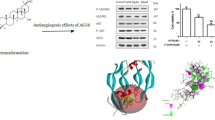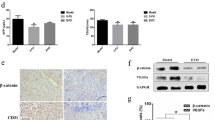Abstract
Purpose
Dihydroartemisinin (DHA) has recently shown antitumor activity in human pancreatic cancer cells. However, its effect on antiangiogenic activity in pancreatic cancer is unknown, and the mechanism is unclear. This study was aimed to investigate whether DHA would inhibit angiogenesis in human pancreatic cancer.
Methods
Cell viability and proliferation, tube formation of human umbilical vein endothelial cells (HUVECs), nuclear factor (NF)-κB DNA-binding activity, expressions of vascular endothelial growth factor (VEGF), interleukin (IL)-8, cyclooxygenase (COX)-2, and matrix metalloproteinase (MMP)-9 were examined in vitro. The effect of DHA on antiangiogenic activity in pancreatic cancer was also assessed using BxPC-3 xenografts subcutaneously established in BALB/c nude mice.
Results
DHA inhibited cell proliferation and tube formation of HUVECs in a time- and dose-dependent manner and also reduced cell viability in pancreatic cancer cells. DHA significantly inhibited NF-κB DNA-binding activity, so as to tremendously decrease the expression of NF-κB-targeted proangiogenic gene products: VEGF, IL-8, COX-2, and MMP-9 in vitro. In vivo studies, DHA remarkably reduced tumor volume, decreased microvessel density, and down-regulated the expression of NF-κB-related proangiogenic gene products.
Conclusions
Inhibition of NF-κB activation is one of the mechanisms that DHA inhibits angiogenesis in human pancreatic cancer. We also suggest that DHA could be developed as a novel agent against pancreatic cancer.







Similar content being viewed by others
References
Jemal A, Murray T, Ward E, Samuels A, Tiwari RC, Ghafoor A (2005) Cancer statistics. CA Cancer J Clin 55:10–30
Liu MP, Ma JY, Pa BR, Ma LS (2001) The study of pancreatic cancer in China. World Chin J Digestol 9:1103–1109
Li D, Xie K, WolV R, Wolff R, Abbruzzese JL (2004) Pancreatic cancer. Lancet 363:1049–1057
Mu D, Zhang W, Chu D, Liu T, Xie Y, Fu E (2008) The role of calcium, P38 MAPK in dihydroartemisinin-induced apoptosis of lung cancer PC-14 cells. Cancer Chemother Pharmac 61:639–645
He Q, Shi J, Shen XL, An J, Sun H, Wang L (2010) Dihydroartemisinin upregulates death receptor 5 expression and cooperates with TRAIL to induce apoptosis in human prostate cancer cells. Cancer Biol Ther 9:819–824
Hou J, Wang D, Zhang R, Wang H (2008) Experimental therapy of hepatoma with artemisinin and its derivatives: in vitro and in vivo activity, chemosensitization, and mechanisms of action. Clin Cancer Res 14:5519–5530
Chen H, Sun B, Wang S, Gao Y, Bai X (2010) Growth inhibitory effects of dihydroartemisinin on pancreatic cancer cells: involvement of cell cycle arrest and inactivation of nuclear factor-kappaB. J Cancer Res Clin Oncol 136:897–903
Wang SJ, Gao Y, Chen H, Kong R, Jiang HC, Pan SH (2010) Dihydroartemisinin inactivates NF-kappaB and potentiates the anti-tumor effect of gemcitabine on pancreatic cancer both in vitro and in vivo. Cancer Lett 293:99–108
Chen H, Sun B, Pan SH, Jiang H, Sun X (2009) Dihydroartemisinin inhibits growth of pancreatic cancer cells in vitro and in vivo. Anticancer Drugs 20:131–140
Chen HH, Zhou HJ, Fang X (2003) Inhibition of human cancer cell line growth and human umbilical vein endothelial cell angiogenesis by artemisinin derivatives in vitro. Pharmacol Res 48:231–236
Chen HH, Zhou HJ, Wang WQ, Wu GD (2004) Antimalarial dihydroartemisinin also inhibits angiogenesis. Cancer Chemother Pharmacol 53:423–432
D’Alessandro S, Gelati M, Basilico N, Parati EA, Haynes RK, Taramelli D (2007) Differential effects on angiogenesis of two antimalarial compounds, dihydroartemisinin and artemisone: implications for embryotoxicity. Toxicology 241:66–74
Efferth T (2006) Molecular pharmacology and pharmacogenomics of artemisinin and its derivatives in cancer cells. Curr Drug Targ 407:407–421
Wartenberg M, Wolf S, Budde P, Grünheck F, Acker H, Hescheler J (2003) The antimalaria agent artemisinin exerts antiangiogenic effects in mouse embryonic stem cell-derived embryoid bodies. Lab Invest 83:1647–1655
Huang XJ, Ma ZQ, Zhang WP (2007) Dihydroartemisinin exerts cytotoxic effects and inhibits hypoxia inducible factor-1alpha activation in C6 glioma cells. J Pharm Pharmacol 59:849–856
Zhou HJ, Wang WQ, Wu GD, Lu YB, Wei EQ (2007) Artesunate inhibits angiogenesis and downregulates vascular endothelial growth factor expression in chronic myeloid leukemia K562 cells. Vascul Pharmacol 47:131–138
Dell’Eva R, Pfeffer U, Vené R, Anfosso L, Forlani A, Albini A (2004) Inhibition of angiogenesis in vivo and growth of Kaposi’s sarcoma xenograft tumors by the anti-malarial artesunate. Biochem Pharmaco 68:2359–2366
Wang W, Abbruzzese JL, Evans DB, Larry L, Cleary KR, Chiao PJ (1999) The nuclear factor-kappa B RelA transcription factor is constitutively activated in human pancreatic adenocarcinoma cells. Clin Cancer Res 5:119–127
Liptay S, Weber CK, Ludwig L, Wagner M, Adler G, Schmid RM (2003) Mitogenic and antiapoptotic role of constitutive NF-κB/Relactivity in pancreatic cancer. Int J Cancer 105:735–746
Xiong HQ, Abbruzzese JL, Lin E, Wang L, Zheng L, Xie K (2004) NF-kappaB activity blockade impairs the angiogenic potential of human pancreatic cancer cells. Int J Cancer 108:181–188
Aggarwal BB (2004) Nuclear factor-κB: the enemy within. Cancer Cell 6:203–208
Folkman J (1986) How is blood vessel growth regulated in normal and neoplastic tissue? G.H.A. Clowes memorial Award lecture. Cancer Res 46:467–473
Gamble JR, Matthias LJ, Meyer G, Kaur P, Russ G, Faull R (1993) Regulation of in vitro capillary tube formation by anti-integrin antibodies. J Cell Biol 121:931–943
Kong R, Sun B, Jiang HC, Pan S, Chen H, Wang S (2010) Downregulation of nuclear factor-κB p65 subunit by small interfering RNA synergizes with gemcitabine to inhibit the growth of pancreatic cancer. Cancer Lett 291:90–98
Nakamura T, Kuwai T, Kim JS, Fan D, Kim SJ, Fidler IJ (2007) Stromal metalloproteinase-9 is essential to angiogenesis and progressive growth of orthotopic human pancreatic cancer in parabiont nude mice. Neoplasia 9:979–986
Singh NP, Lai HC (2004) Artemisinin induces apoptosis in human cancer cells. Anticancer Res 24:2277–2280
Matsuo Y, Sawai H, Ochi N, Yasuda A, Sakamoto M, Takahashi H (2010) Proteasome inhibitor MG132 inhibits angiogenesis in pancreatic cancer by blocking NF-κB activity. Dig Dis Sci 55:1167–1176
Itakura J, Ishiwata T, Friess H, Fujii H, Matsumoto Y, Büchler MW (1997) Enhanced expression of vascular endothelial growth factor in human pancreatic cancer correlates with local disease progression. Clin Cancer Res 3:1309–1316
Shi Q, Abbruzzese JL, Huang S, Fidler IJ, Xiong Q, Xie K (1999) Constitutive and inducible interleukin 8 expression by hypoxia and acidosis renders human pancreatic cancer cells more tumorigenic and metastatic. Clin Cancer Res 5:7234–7243
Gupta MK, Qin RY (2003) Mechanism and its regulation of tumor-induced angiogenesis. World J Gastroenterol 9:1144–1155
Koch AE, Polverini PJ, Kunkel SL, Harlow LA, DiPietro LA, Elner VM (1992) Interleukin-8 as a macrophage-derived mediator of angiogenesis. Science 258:1798–1801
Huang S, Robinson JB, Deguzman A, Bucana CD, Fidler IJ (2000) Blockade of nuclear factor-kappaB signaling inhibits angiogenesis and tumorigenicity of human ovarian cancer cells by suppressing expression of vascular endothelial growth factor and interleukin 8. Cancer Res 60:5334–5339
Ko HM, Kang JH, Choi JH, Park SJ, Bai S, Im SY (2005) Platelet-activating factor induces matrix metalloproteinase-9 expression through Ca(2+)- or PI3K-dependent signaling pathway in a human vascular endothelial cell line. FEBS Lett 579:6451–6458
Bergers G, Brekken R, McMahon G, Vu TH, Itoh T, Tamaki K (2000) Matrix metalloproteinase-9 triggers the angiogenic switch during carcinogenesis. Nat Cell Biol 2:737–744
Plummer SM, Holloway KA, Manson MM, Munks RJ, Kaptein A, Farrow S (1999) Inhibition of cyclooxygenase 2 expression in colon cells by the chemopreventive agent curcumin involves inhibition of NF-kappaB activation via the NIK/IKK signalling complex. Oncogene 18:6013–6020
Masferrer JL, Leahy KM, Koki AT, Zweifel BS, Settle SL, Woerner BM (2000) Antiangiogenic and antitumor activities of cyclooxygenase-2 inhibitors. Cancer Res 60:1306–1311
Rozic JG, Chakraborty C, Lala PK (2001) Cyclooxygenase inhibitors retard murine mammary tumor progression by reducing tumor cell migration, invasiveness and angiogenesis. Int J Cancer 93:497–506
Chu JS, Lloyd FL, Trifan OC, Knapp B, Rizzo MT (2003) Potential involvement of the cyclooxygenase-2 pathway in the regulation of tumor-associated angiogenesis and growth in pancreatic cancer. Mol Cancer Ther 2:1–7
Acknowledgments
This work was supported in part by grants from the New Century Support Foundation for Elitist of Chinese Ministry of Education (NCET-07-0248), the Scientific Foundation for Prominent Youth of Heilongjiang Province, China (JC200717), the Scientific and Technological Project of Heilongjiang Province, China (GC09C407-2), and the National Natural Scientific Foundation of China (30571808, 30872987). The authors would like to extend their gratefulness to Ming Mu for her technical assistance.
Conflict of interest
No conflict of interest.
Author information
Authors and Affiliations
Corresponding author
Rights and permissions
About this article
Cite this article
Wang, SJ., Sun, B., Cheng, ZX. et al. Dihydroartemisinin inhibits angiogenesis in pancreatic cancer by targeting the NF-κB pathway. Cancer Chemother Pharmacol 68, 1421–1430 (2011). https://doi.org/10.1007/s00280-011-1643-7
Received:
Accepted:
Published:
Issue Date:
DOI: https://doi.org/10.1007/s00280-011-1643-7




